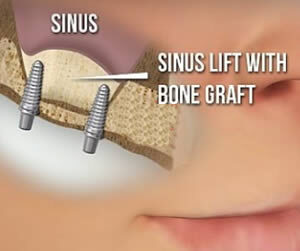Adding bone to the upper jaw near the molars or premolars is called a sinus lift or sinus augmentation. The sinus membrane is lifted or moved upward so that there is room for the additional bone and implant placement.
Purpose
Sinus lifts are a common procedure due to the popularity of dental implants to replace missing teeth. When dental implants can’t be effectively placed because there is insufficient bone height in the upper jaw or the sinuses are too near the jaw, a sinus lift is usually necessary. Common causes of a sinus lift include:
- Tooth loss in the upper jaw, especially the back teeth, which does not have adequate bone structure for supporting dental implants. The back of the upper jaw is known for having less bone than the lower jaw due to the skull’s anatomy.
- Periodontal or gum disease that leads to bone loss.
- Bone loss due to the bone being absorbed back into the body when the teeth have been missing for an extended period of time.
- Location of the maxillary sinus being too close to the upper jaw so that implants can’t be successfully placed. Sinus shapes and sizes are different for everyone and may also grow with age.
Before
Diagnostic tests like X-rays or CT scans may be needed to assist the dentist in seeing the jaw and sinus anatomy. These tests also allow for accurate measurements of the height and width of the bone, as well as view the overall sinus condition. If a sinus lift is recommended, it should be performed at a time when seasonal allergies are not present. The sinus membrane is lifted with PRF membrane and freeze-dried bone particulates.
During
An incision in the gum tissue is performed where the missing back teeth were located. The bone is exposed by raising the tissue to create a small window. On the other side of the window is a membrane lining the sinus that separates the sinus and jaw. The membrane is pushed up and away from the jaw so that PRF bone graft material can be placed in the area where the sinus was. Several millimeters of bone is typically added, although it varies by patient. Typically, the implant is placed at the same appointment. The tissue is stitched closed after the bone is placed. Then time is allowed for the bone graft to mesh with the bone, which may take from four to nine months depending on how much bone was added.
After
Minor discomfort can be expected following a sinus lift. Pain medication, antibiotics, and antimicrobial mouthwash may be prescribed to avoid infection. Common things to expect after the procedure are minor swelling or bleeding from the mouth or nose. Care must be taken to avoid forceful sneezing or nose blowing, which could loosen the stitches or shift the bone graft. Saline sprays may be recommended to maintain moisture in the nose lining. Medication to prevent inflammation and congestion may be prescribed. After 7 to 10 days, the patient will return to the dentist for stitch removal if they don’t self-dissolve. Further checkups may be advised to check progress. Platelet-rich plasma containing growth factors taken from the patient’s blood and mixed with the bone graft. Approved by the U.S. Food and Drug Administration, an alternative engineered protein called human-recombinant bone morphogenetic protein may be used to stimulate bone formation without grafting.
Risks
Tear or puncture of the sinus membrane is the primary risk during a sinus lift. If this occurs during surgery, the PRF membrane placed against the sinus membrane will act as a patch. The good news is that a healed membrane often is stronger and thicker, increasing the success rate of the second sinus lift. Additional risks are possible with sinus lift surgery, such as infection or non-integration of the bone graft which decreases blood supply to the area. In this case, an implant will not be effective since there is no living bone to connect with. Another sinus lift surgery would be required. Reasons to contact the dentist during recovery include worsening pain or swelling over time, bleeding that continues more than two days, bright red continuous bleeding, fever, or possible dislodge of the bony material from a sneeze or nose blow. If any of those things occur, the patient should seek assistance from the dentist to ensure the most successful outcome of sinus lift surgery.


